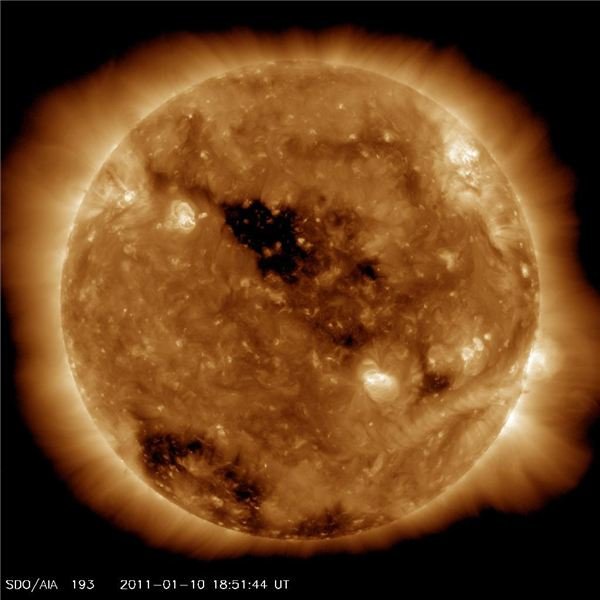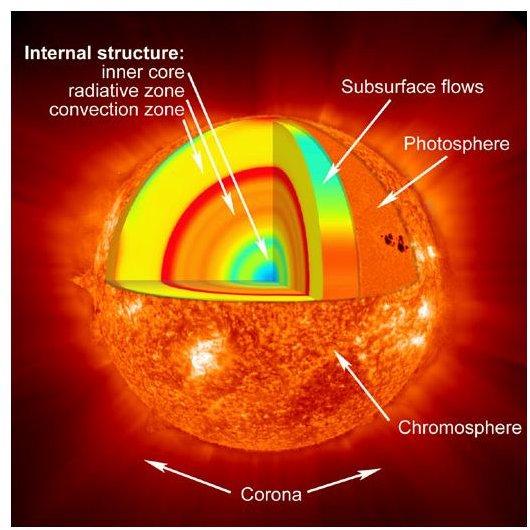Defining and Describing the Phenomena of a Coronal Hole
The Corona
Layers of the Sun - Courtesy NASA
The solar corona (the plasma outer layer of the Sun’s atmosphere) is 1.7 million degrees Kelvin—magnitudes hotter than the Sun’s chromosphere and photosphere1 underlayers. Historically, the solar magnetic field has been considered the source for such high temperatures; however it may be that no one process, but a number of processes work together to accomplish this.
A fascinating added feature—the Sun’s corona has been discovered to have holes in it. These holes are not revealed in ordinary visible wavelength photographic studies. Why not? It has to do with the corona’s high temperature. At elevated temperatures, a high percentage of the energy emitted falls in the ultraviolet and x-ray portions of the electromagnetic spectrum.
The Sun’s Magnetic Field
Most people are familiar with lines of magnetic force, such as are generated by a bar magnet. A bar magnet placed under a piece of paper sprinkled with iron filings aligns the particles into arcs or loops. At the bar’s ends, the appearance may be different. Open field lines can be seen. For the Sun, such lines exit the Sun’s surface and extend way out into space. Where this occurs, there are holes in the corona, and the surface looks relatively dark inside.
Coronal holes during periods of low solar activity are most prominent at the Sun’s northern and southern poles. During busier times, coronal holes appear also at other latitudes of the Sun’s surface. The holes are dark because the magnetic lines vertically penetrating the Sun’s surface in them hinders heat convection, whereas there is no such hindrance outside the coronal holes.
What Underlies Coronal Hole Fluctuation and Movement?

Since coronal holes are caused by the Sun’s magnetic field, changes in them must be reflected by an ever-changing magnetic field. Why is the Sun’s magnetic field not relatively static? It is complex and due to a host of factors, which include the variability of the Sun’s rotation rate with latitude, and the charges and fluidity of its plasma. The charged particles strongly influence its magnetic field. The metastable magnetic field produces coronal holes varying in size and in location.
Image Courtesy NASA/SDO/AIA
What Phenomena Originate at Coronal Holes?
Charged particles escape the surface of the Sun through coronal holes. The steady stream escaping constitutes the high-speed component of what is called the “solar wind.” This solar wind travels at approximately 400 kilometers per second (about one million miles-per-hour). It is the solar wind that (at least in part) causes the tails of comets to point away from the Sun. The solar wind is also responsible for fluctuations in the Earth’s magnetosphere, and can produce solar storms therein. As a result, the solar wind can disrupt communications and interfere with navigation systems.2 Coronal holes are the object of study at a number of leading institutions, including in their number NASA, Harvard, and Florida State University.
1 For further information on the Sun’s photosphere, see George Adcock’s, “The Photosphere of the Sun.”
2 Another feature affected with communications interference is sunspots. Enjoy further enlightenment concerning sunspots in the article, “Mysteries of the Sun: The Maunder Minimum and Sunspots.”
References and Resources
NASA – “Why is the Sun’s Corona so Hot?”: https://sunearthday.nasa.gov/2008/TTT/58_hotcorona.php
NASA – Holes in the Sun’s Corona: https://www.nasa.gov/mission_pages/sdo/news/news20110111-corona-hole.html
Florida State University, Molecular Expressions – Magnetic Field Lines (Java Demo)
Harvard University – Coronal Holes: https://www.cfa.harvard.edu/~scranmer/Preprints/eaaa_holes.pdf
